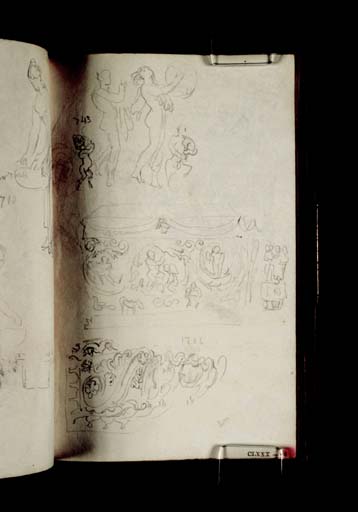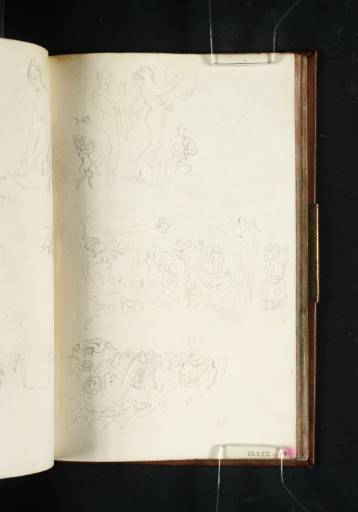Joseph Mallord William Turner Studies of Sculptural Fragments from the Vatican Museums, Including a Relief with a Satyr and Maenad and the Sarcophagus of Constantia 1819
Image 1 of 2
-
 Joseph Mallord William Turner, Studies of Sculptural Fragments from the Vatican Museums, Including a Relief with a Satyr and Maenad and the Sarcophagus of Constantia 1819
Joseph Mallord William Turner, Studies of Sculptural Fragments from the Vatican Museums, Including a Relief with a Satyr and Maenad and the Sarcophagus of Constantia 1819 -
 Joseph Mallord William Turner, Studies of Sculptural Fragments from the Vatican Museums, Including a Relief with a Satyr and Maenad and the Sarcophagus of Constantia 1819 (Enhanced image)Enhanced image
Joseph Mallord William Turner, Studies of Sculptural Fragments from the Vatican Museums, Including a Relief with a Satyr and Maenad and the Sarcophagus of Constantia 1819 (Enhanced image)Enhanced image
Joseph Mallord William Turner,
Studies of Sculptural Fragments from the Vatican Museums, Including a Relief with a Satyr and Maenad and the Sarcophagus of Constantia
1819
Joseph Mallord William Turner 1775–1851
Folio 47 Recto:
Studies of Sculptural Fragments from the Vatican Museums, Including a Relief with a Satyr and Maenad and the Sarcophagus of Constantia 1819
D15194
Turner Bequest CLXXX 46
Turner Bequest CLXXX 46
Pencil on white wove paper, 161 x 101 mm
Inscribed by the artist in pencil (see main catalogue entry)
Inscribed by John Ruskin in red ink ‘46’ bottom right
Stamped in black ‘CLXXX 46’ bottom right
Inscribed by John Ruskin in red ink ‘46’ bottom right
Stamped in black ‘CLXXX 46’ bottom right
Accepted by the nation as part of the Turner Bequest 1856
References
1909
A.J. Finberg, A Complete Inventory of the Drawings of the Turner Bequest, London 1909, vol.I, p.533, as ‘Bacchanal, from the Villa Mattei – No. “743”; also No. “1206”, &c.’.
1984
Cecilia Powell, ‘Turner on Classic Ground: His Visits to Central and Southern Italy and Related Paintings and Drawings’, unpublished Ph.D thesis, Courtauld Institute of Art, University of London 1984, pp.418, 476 note 8, as ‘(a) Fragment of a relief with a satyr and maenad (A, II, pl.62, 418) (b) The sarcophagus of Constantia (RR, 369, 2) (c) An architectural detail’.
1987
Cecilia Powell, Turner in the South: Rome, Naples, Florence, New Haven and London 1987, p.51 note 6.
During his 1819 stay in Rome, one of Turner’s most extensive sketching campaigns was the large number of pencil studies made from the sculpture collections of the Vatican Museums (for a general discussion, see the introduction to the sketchbook). This page contains sketches of objects found in the Museo Pio-Clementino. The studies are numbered from top to bottom:
a.
Cecilia Powell has identified the sketch in the top left-hand corner as a fragment of a relief with a satyr and maenad.1 The object can be found in the Galleria delle Statue (Gallery of Statues, formerly also known as the Gallery of Cleopatra).2 Turner has annotated the drawing with the number ‘743’.
b.
Powell has identified the central sketch as depicting the Sarcophagus of Constantina, a red porphyry tomb decorated with reliefs from the Mausoleum of Costanza next to the Basilica of Sant’Agnese fuori le mura (see the Small Roman C. Studies sketchbook, Tate D16454; Turner Bequest CXC 40).3 The sarcophagus still stands in situ in the Sala a Croce Greca (Hall of the Greek Cross),4 and can be seen in a drawing by James Hakewill (1778–1843), Rome. Museum of the Vatican. Sala a croce greca looking to the Rotonda (British School at Rome Library), an illustration which was engraved for Hakewill’s Picturesque Tour of Italy, published 1818.5 Turner, who collaborated with Hakewill on other illustrations for this project, made a couple of similar general sketches of the Sala a Croce Greca, see folios 48 and 48 verso (D15196 and D15197; Turner Bequest CLXXX 47 and 47a). He also recorded the other large sarcophagus on the opposite side of this room, that belonging to Helena, the mother of Constantine, see folio 47 verso (D15195; Turner Bequest CLXXX 46a).
c.
The sketch at the bottom of the page represents a decorative corbel, also found in the Sala a Croce Greca, supporting a statue of a man holding a cornucopia. Turner has annotated the drawing with the number ‘1206’.
Cecilia Powell has identified the sketch in the top left-hand corner as a fragment of a relief with a satyr and maenad.1 The object can be found in the Galleria delle Statue (Gallery of Statues, formerly also known as the Gallery of Cleopatra).2 Turner has annotated the drawing with the number ‘743’.
b.
Powell has identified the central sketch as depicting the Sarcophagus of Constantina, a red porphyry tomb decorated with reliefs from the Mausoleum of Costanza next to the Basilica of Sant’Agnese fuori le mura (see the Small Roman C. Studies sketchbook, Tate D16454; Turner Bequest CXC 40).3 The sarcophagus still stands in situ in the Sala a Croce Greca (Hall of the Greek Cross),4 and can be seen in a drawing by James Hakewill (1778–1843), Rome. Museum of the Vatican. Sala a croce greca looking to the Rotonda (British School at Rome Library), an illustration which was engraved for Hakewill’s Picturesque Tour of Italy, published 1818.5 Turner, who collaborated with Hakewill on other illustrations for this project, made a couple of similar general sketches of the Sala a Croce Greca, see folios 48 and 48 verso (D15196 and D15197; Turner Bequest CLXXX 47 and 47a). He also recorded the other large sarcophagus on the opposite side of this room, that belonging to Helena, the mother of Constantine, see folio 47 verso (D15195; Turner Bequest CLXXX 46a).
c.
The sketch at the bottom of the page represents a decorative corbel, also found in the Sala a Croce Greca, supporting a statue of a man holding a cornucopia. Turner has annotated the drawing with the number ‘1206’.
A description of the Sala a Croce Greca and the Sarcophagus of Constantia can be found in John Chetwode Eustace’s, A Classical Tour Through Italy, first published in 1813:
From this [Sala] Rotonda ... a rich portal conducts into the Sala a Croce Greca ... supported by columns paved with ancient mosaic, furnished with statues and lined with basso relievos. One object naturally attracts attention. It is a vast sarcophagus formed with its lid of one block of red porphyry, beautifully ornamented in basso relievo with little infant Cupids employed in the vintage, and bordered with tendrils and arabesques. It once contained the ashes of Constantia the daughter of Constantine the great, and stood for ages in her mausoleum near the Church of St. Agnes without the Porta Pia Nomentana. At length Alexander IV converted the mausoleum into a church, and ordered the body of the Princess to be deposited, as that of a saint, under the altar; a motive which removes all imputation of guilt from the deed, though it would have been more prudent, as well as more respectful, to allow the body to remain undisturbed in the tomb to which it had been consigned by the hands of a father. The sarcophagus long remained a useless ornament, and was later transported to the Museum.6
The artist made notes from this passage in the Italian Guide Book sketchbook (see Tate D13948; CLXXII 9a).
Turner’s annotations presumably relate to exhibit numbers displayed on the individual works. However, they do not appear to correspond to any known lists published within contemporary guide books or catalogues of the Vatican collections.
Nicola Moorby
November 2009
Powell 1984, p.418; see Walther Amelung, Die Sculpturen des Vaticanischen Museums, Berlin 1903–8, vol.II, ‘4. Galleria delle Statue. II’, no.418, p.659, reproduced pl.62.
Giandomenico Spinola, Il Museo Pio-Clementino, vol.II, Vatican City 1999, no.GS 2, p.12, reproduced fig.1.
Powell 1984, p.481; see Salomon Reinach Répertoire de Reliefs Grecs et Romains, vol.3, Paris 1912, 369, 2.
Georg Lippold, Die Skulpturen des Vaticanischen Museums, vol.III, no.I, Berlin 1956, no.566, reproduced pl.566; and Giandomenico Spinola, Il Museo Pio-Clementino, vol.II, Vatican City 1999, no.SCG 71, p.305, reproduced fig.46.
How to cite
Nicola Moorby, ‘Studies of Sculptural Fragments from the Vatican Museums, Including a Relief with a Satyr and Maenad and the Sarcophagus of Constantia 1819 by Joseph Mallord William Turner’, catalogue entry, November 2009, in David Blayney Brown (ed.), J.M.W. Turner: Sketchbooks, Drawings and Watercolours, Tate Research Publication, December 2012, https://www

